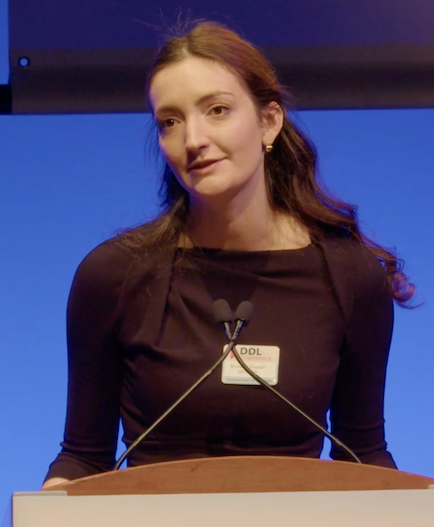Following Dailey, Zorana Anderson of the University of Copenhagen, who is the chair of the European Respiratory Society (ERS) Environment and Health Committee, also addressed the threat of airborne particulates in her talk titled, “Climate change, air pollution, and their well-documented harmful effects on human (lung) health,” in which she provided an overview of the increasing threat of air pollution and its effects on the entire body, not just the lung.
Thomas Gutsmann of the Leibniz Lung Center and the University of Lübeck described research on the risks of pathogens transported by dust, with data demonstrating the health impact of microbes carried on dust from the Sahara on residents of the Cape Verde islands and insights into how bacteria bind to the dust particles.
The Pat Burnell Young Investigator Award
All of the research presented by finalists for The Pat Burnell Young Investigator Award focused either on nonclinical testing methods or on novel formulations. Two of the finalists presented work on models: Scott Tavernini of the University of Alberta explained his work on “Predicting Systemic Exposure to Inhaled Drugs using a Simplified Regional Deposition and Pharmacokinetic Method,” and Adeel Ahmed of the University of Hertfordshire spoke about “Developing a Combined Calu-3 Barrier and Smooth Muscle Model of the Airways Utilizing a Perfused Microphysiological System.”
The remaining three finalists presented research on formulation. Two of those three are associated with CDMO Hovione: Ricardo Velez, who presented his poster on “Enhanced Lung Delivery of mRNA Using Nebulized Lipid Nanoparticles” and Patricia Henriques, the winner of the was named the winner of this year’s VCU RDD Peter R. Byron Graduate Student Award For Excellence, who presented a poster titled, “Amorphous Spray Dried Microparticles for Nasal Delivery: Tackling Solubility Challenges while Targeting Systemic Nasal Absorption.”
The fifth finalist, Brunella Grassiri of the University of Pisa presented her poster on “Development of pulmonary formulations with gallium siderophores against Aspergillus fumigatus lung infections.” Grassiri discussed the “unconventional strategy of exploiting microbial nutritional vulnerabilities” with inhaled formulations of a gallium-siderophore complex, that has a “Trojan Horse mechanism of action,” where the siderophore “masks” the presence of the gallium. The novel formulations work by displacing Fe³⁺ that is essential for microbial metabolism with GA³⁺, and the infection site has a particularly high demand for iron, she explained. Responding to an audience question, Grassiri said that both in vivo and in vitro testing had demonstrated GS1’s activity against P. aeruginosa in addition to A. fumigatus. In response to a question from moderator Ben Forbes about which formulation she created — nebulized or dry powder — that she would move forward with, Grassiri suggested that both should move forward since each would be useful to different populations.



